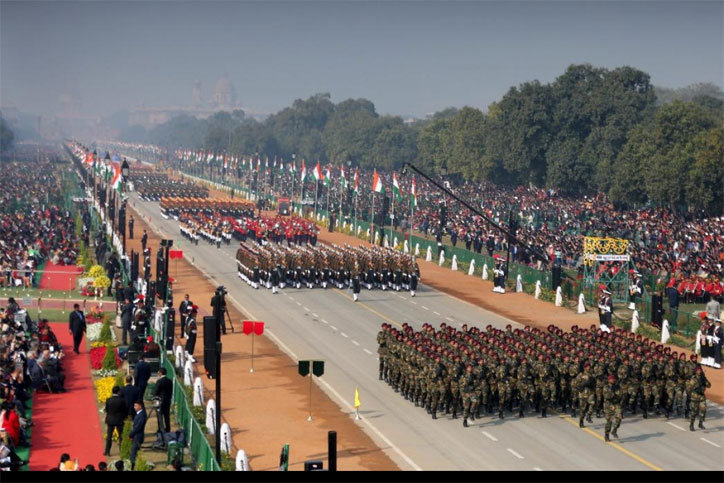By FnF Desk | PUBLISHED: 24, Jan 2021, 20:57 pm IST | UPDATED: 27, Jan 2021, 13:18 pm IST

Republic Day is celebrated every year in India on January 26 and this time the country will mark its 72nd Republic Day. On this day, the Constitution of India came into effect. Indian was a colony of the British for over 200 years and after that, it became independent from the rule of the British Raj following the struggle of the Indian independence movement.
History of Republic Day
For the unversed, the Congress party demanded purna swaraj on the last Sunday of January 1930, which fell on January 26. On December 9, 1946, the Constituent Assembly met for the first time in New Delhi in the Constitution Hall, and thus after that, a drafting committee was appointed and Dr B R Ambedkar was appointed as the chairman of the committee. The Constituent Assembly took almost three years (two years, eleven months and seventeen days to be precise) to complete the drafting of the Constitution for Independent India. The Constitution was adopted by the Indian Constituent Assembly on 26 November 1949. It came into effect on January 26, 1950.
Celebrations Galore
Republic Day is celebrated every year with much enthusiasm all over the country and to mark the importance of this occasion, a grand parade is held in the capital, New Delhi, from Raisina Hill near the Rashtrapati Bhavan (President's House), along the Rajpath, past India Gate and on to the historic Red Fort.
The event begins with the Prime Minister of India laying a wreath at the Amar Jawan Jyoti at India Gate, commemorating all the soldiers who sacrificed their lives for the country. Soon, a 21 gun salute is presented, the President unfurls the National Flag and the National Anthem is played. This marks the beginning of the parade. The President is accompanied by a notable foreign Head of State - who is the invited Chief Guest at the celebration.
The Parade begins with winners of gallantry awards passing the President in open jeeps. President of India, who is the Commander-in-Chief of the Indian Armed Forces, takes the salute at the grand parade. The Indian Military also showcases its latest acquisitions such as tanks, missiles, radars, etc. Soon after, awards and medals of bravery are given by the President to the people from the armed forces for their exceptional courage in the field and also to those civilians who have distinguished themselves by their different acts of valour in different situations.
After this, helicopters from the armed forces fly past the parade area showering rose petals on the audience. The military parade is followed by a colourful cultural parade. India's rich cultural heritage is depicted in the form of tableaus from various states. Each state depicts its unique festivals, historical locations and art. This exhibition of diversity and richness of the culture of India lends a festive air to the occasion.
Tableaus from various government department and ministries of India are also presented displaying their contribution towards the progress of the nation. The most cheered section of the parade is when the children who have won National Bravery Awards ride past the dais on elephants. School-children from all over the country also participate in the parade showcasing folk dances and singing to the tunes of patriotic songs.
The parade also includes displays of skilful motor-cycle rides, by the Armed Forces personnel. The most eagerly awaited part of the parade is the fly past, put on by the Indian Air Force. The fly past marks the conclusion of the parade, when fighter planes of the IAF roar past the dais, symbolically saluting the President.
Live Webcast of the Republic Day Parade is made available every year to millions of surfers who wish to view the parade over the Internet. After the event is over, the exclusive footage is made available as 'video on demand'. Celebrations, though on a relatively smaller scale, are also held in all state capitals, where the Governor of the state unfurls the Tricolour. Similar celebrations are also held at district headquarters, sub divisions, talukas, and panchayats.
PM Rally
The Republic Day celebration is a three day extravaganza and post this celebration at India Gate, on the 27th January, a Prime Minister's Rally is held by a crème of N.C.C cadets displaying various breath-taking performances and drill.
Lok Tarang
The Ministry of Culture, Government of India, in association with seven Zonal Cultural Centres organises "Lok Tarang, - National Folk Dance Festival" every year from 24th to 29th January. This festival provides a unique opportunity for people to witness colourful, vibrant and authentic folk dances drawn from various parts of the country.
Beating the Retreat
Beating The Retreat officially denotes the end of Republic Day festivities. All important Government Buildings are beautifully decorated with lights every evening from 26th to 29th. Beating the Retreat ceremony is conducted on the evening of January 29, the third day after the Republic Day. The ceremony starts by the massed bands of the three services marching in unison, playing popular marching tunes.
The drummers also give a solo performance (known as the Drummer's Call). Followed by this the drummers play Abide With Me (which is also said to be GandhiJi's favourite) and the chimes made by the tubular bells, placed quite at a distance, create a mesmerising ambience.
This is followed by the bugle call for Retreat, the band master then marches to the President and requests permission to take the bands away, and informs that the closing ceremony is now complete. The bands march back playing a popular martial tune Saare Jahan Se Achcha. At exactly 6 pm, the buglers sound the retreat and the National Flag is lowered, and the National Anthem is sung, bringing the Republic Day celebrations to a formal end.

by : Priti Prakash
When Russian President Vladimir Putin landed in New Delhi for the 23rd India–Russia Annual Summit ...